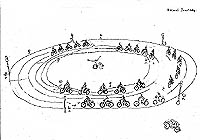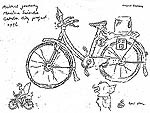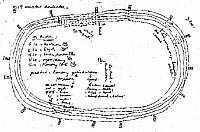|
 |
 |
 |
|
Heri DONO's drawings for Animal
Journey |
|
In addition to this installation, there are two sound art
works that will be included in the Harima opening project. One
is a work entitled "Animal Journey" by the Indonesian
artist Heri DONO. The other is "Pianola Plantron(tentative
title)" by the botanist DOGANE Yuji and the composer Fujieda
Mamoru. Dono is a fine artist, who has received much attention
for "Gamelan of Rumor," a piece that was shown at the
Fukuoka City Museum, and "Glass Vehicle," which was
shown at the Japan Foundation's ASEAN Culture Center, and is
known for work that frequently incorporates sound. According
to Dono including sound in his work was only natural, and for
this event, he will present a daring new piece that is based
on the sounds of 25 bicycles.
A tape recorder is connected to each bicycle, and the tape
is played using energy generated by people pumping the pedals.
Depending on how fast the bicycle is pedaled, the tape speeds
up or slows down. On the tape, various kinds of Indonesian animal
sounds can be heard at a variety of speeds. This explains the
name of the piece. Not only an installation, this work is also
a performance. The bicycles are set up in a round formation as
if they were on a race track with five bicycles in each of the
five lanes. When the signal is given by the conductor, sound
is produced as the performers begin to pedal away. At the traffic
signal set up around the track, animal masks are donned and riding
continues. Alongside them, other performers flatten themselves
down on the seats of Indonesian tricycles and beat Japanese drums
as they ride around.
"Plantron," on the other hand, has been performed
in a number of forms in the past, but for this event, computer
interface will be connected from the plants to five digital pianos,
where the data will be converted into sound in a new version
called "Pianola Plantron(tentative title)." In past
versions, the sounds that were emitted caused the piano strings
to reverberate, and without any further modifications were run
through speakers. But this time, digital signals will be sent
to the MIDI pianos, and these will be converted into piano sounds,
which will be tuned in Just Intonation. The sound of this installation
will change the space of the Center for Advanced Science and
Technology into a garden filled with piano sounds emitted by
plants.
|
|




